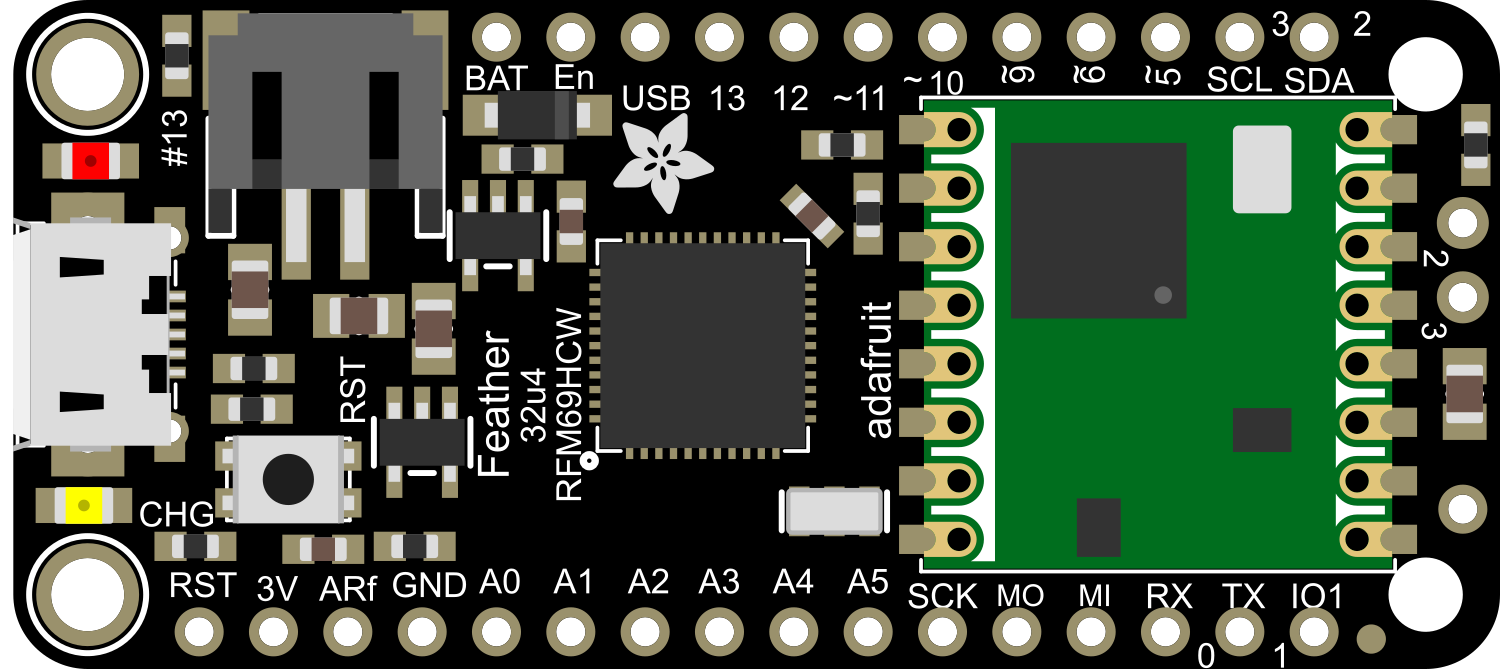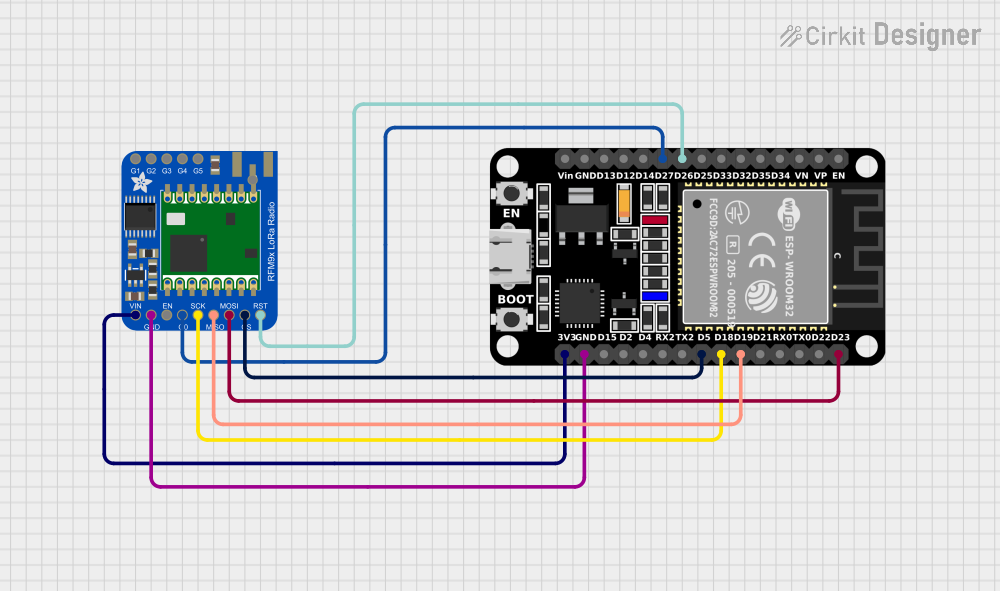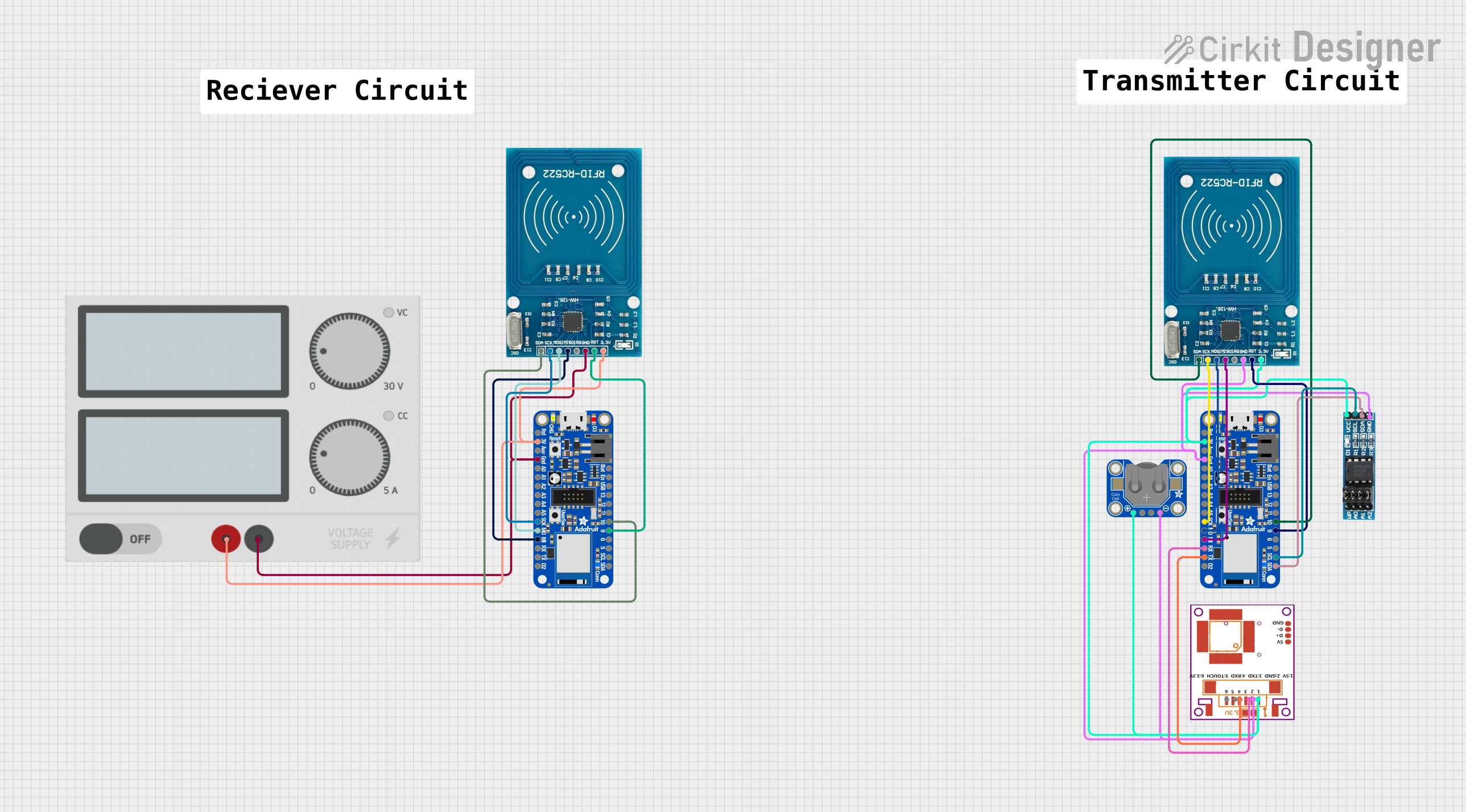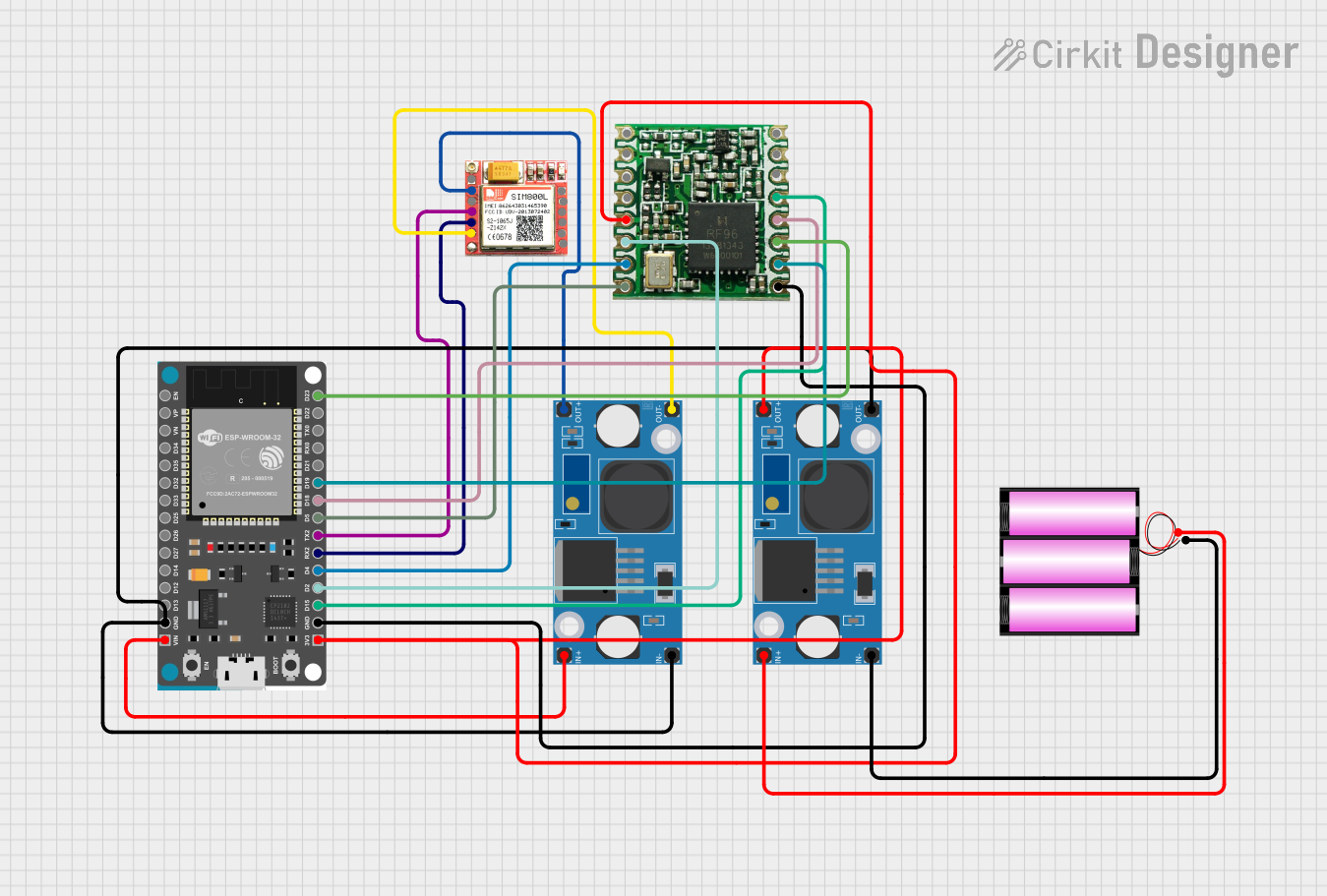
How to Use Adafruit Feather 32u4 RFM9x: Examples, Pinouts, and Specs

 Design with Adafruit Feather 32u4 RFM9x in Cirkit Designer
Design with Adafruit Feather 32u4 RFM9x in Cirkit DesignerIntroduction
The Adafruit Feather 32u4 RFM9x is a versatile and compact development board that combines the power of the ATmega32u4 microcontroller with the long-range wireless capabilities of the RFM9x LoRa radio module. This board is part of the Feather ecosystem, designed by Adafruit for portability, ease of use, and interoperability with a wide range of FeatherWings (add-on boards). It is ideal for applications such as remote sensors, home automation, and IoT devices where long-range communication is essential.
Explore Projects Built with Adafruit Feather 32u4 RFM9x

 Open Project in Cirkit Designer
Open Project in Cirkit Designer
 Open Project in Cirkit Designer
Open Project in Cirkit Designer
 Open Project in Cirkit Designer
Open Project in Cirkit Designer
 Open Project in Cirkit Designer
Open Project in Cirkit DesignerExplore Projects Built with Adafruit Feather 32u4 RFM9x

 Open Project in Cirkit Designer
Open Project in Cirkit Designer
 Open Project in Cirkit Designer
Open Project in Cirkit Designer
 Open Project in Cirkit Designer
Open Project in Cirkit Designer
 Open Project in Cirkit Designer
Open Project in Cirkit DesignerCommon Applications and Use Cases
- Remote environmental monitoring (temperature, humidity, etc.)
- Home automation networks
- IoT devices with long-range communication needs
- Wireless sensor networks
- Low-power, long-range messaging systems
Technical Specifications
Key Technical Details
- Microcontroller: ATmega32u4
- Operating Voltage: 3.3V
- Input Voltage: 3.7-6V via battery, up to 12V via USB or VIN pin
- Clock Speed: 8 MHz
- Digital I/O Pins: 20
- PWM Channels: 7
- Analog Input Channels: 12
- DC Current per I/O Pin: 40 mA
- Flash Memory: 32 KB (ATmega32u4) of which 4 KB used by bootloader
- SRAM: 2.5 KB (ATmega32u4)
- EEPROM: 1 KB (ATmega32u4)
- Radio Module: RFM95W/RFM96W (LoRa)
- Frequency: 433MHz or 868/915MHz (region-specific)
- Transmit Power: Up to +20 dBm
- Range: Up to 2 km with provided wire antenna
Pin Configuration and Descriptions
| Pin Number | Function | Description |
|---|---|---|
| 1 | GND | Ground |
| 2 | 3V3 | 3.3V power supply output |
| 3 | AREF | Analog reference voltage for ADC |
| 4 | A0-A5 | Analog input pins |
| 5 | 6-9, 10-13 | Digital I/O pins, PWM capable (on some pins) |
| 6 | 14 (MISO) | SPI data input |
| 7 | 15 (SCK) | SPI clock |
| 8 | 16 (MOSI) | SPI data output |
| 9 | 17 (SS) | SPI slave select |
| 10 | RX and TX | UART receive and transmit |
| 11 | SDA and SCL | I2C data and clock lines |
| 12 | RST | Reset pin |
| 13 | BAT | Battery voltage (for battery-powered applications) |
| 14 | USB | Micro-USB connection for programming/power |
| 15 | RFM9x DIO0-DIO5 | Radio module digital I/O pins |
Usage Instructions
How to Use the Component in a Circuit
Powering the Board:
- The Feather 32u4 RFM9x can be powered via the USB connection, a LiPo battery, or through the VIN pin.
- Ensure that the power source is within the specified voltage range to prevent damage.
Programming:
- Connect the board to your computer using a micro-USB cable.
- Select "Adafruit Feather 32u4" from the Tools > Board menu in the Arduino IDE.
- Choose the correct port from Tools > Port.
Integrating the RFM9x Radio:
- Use the provided RFM9x DIO pins to interface with the radio module.
- Ensure that the antenna is properly connected to achieve the maximum range.
Interfacing with Sensors and Actuators:
- Utilize the digital and analog pins to connect various sensors and actuators.
- Remember to configure the pins correctly in your code (as input or output).
Important Considerations and Best Practices
- Antenna: Always use the board with an antenna connected to the RFM9x module to avoid damaging the transmitter.
- Power Consumption: To achieve low-power operation, utilize sleep modes and minimize the duty cycle of radio transmissions.
- Interference: Be aware of potential interference in the operating environment, which can affect communication range and reliability.
- Regulatory Compliance: Ensure that your use of the radio module complies with local regulations regarding radio frequency and power output.
Troubleshooting and FAQs
Common Issues
- Board not recognized by computer:
- Check the USB cable and connections.
- Ensure that the correct drivers are installed.
- Radio communication not working:
- Verify that the antenna is properly connected.
- Check that the frequency and settings match on both the transmitting and receiving devices.
- Low range or unreliable communication:
- Ensure there are no obstructions or sources of interference.
- Consider using a higher gain antenna or adjusting the placement of the device.
Solutions and Tips for Troubleshooting
- Reset the board: If the board is unresponsive, try pressing the reset button.
- Update the bootloader: If you have issues uploading sketches, it may be necessary to update the bootloader using an ISP programmer.
- Check solder joints: If you've soldered headers or components to the board, ensure that all connections are solid and there are no shorts.
FAQs
- Q: Can I use the Feather 32u4 RFM9x with a different microcontroller?
- A: Yes, you can communicate with the RFM9x module using SPI, which is available on many microcontrollers.
- Q: What is the maximum range I can achieve with this board?
- A: The range can vary greatly depending on the environment, but with line-of-sight and proper settings, you can achieve up to 2 km.
- Q: Can I use this board with the Arduino IDE?
- A: Yes, the Feather 32u4 RFM9x is fully compatible with the Arduino IDE.
Example Code for Arduino UNO
Below is a simple example code snippet that demonstrates how to initialize the RFM9x module with an Arduino UNO. This code assumes you have the appropriate library installed (e.g., RadioHead library).
#include <SPI.h>
#include <RH_RF95.h>
// Singleton instance of the radio driver
RH_RF95 rf95;
void setup() {
Serial.begin(9600);
while (!Serial) ; // Wait for serial port to be available
if (!rf95.init())
Serial.println("init failed");
}
void loop() {
// Send a message every 3 seconds
if (rf95.available()) {
// Should be a message for us now
uint8_t buf[RH_RF95_MAX_MESSAGE_LEN];
uint8_t len = sizeof(buf);
if (rf95.recv(buf, &len)) {
Serial.print("Got: ");
Serial.println((char*)buf);
} else {
Serial.println("Receive failed");
}
}
}
Remember to install the RadioHead library before uploading this code to your Arduino UNO. This example is for demonstration purposes and may require modifications to work with your specific setup.